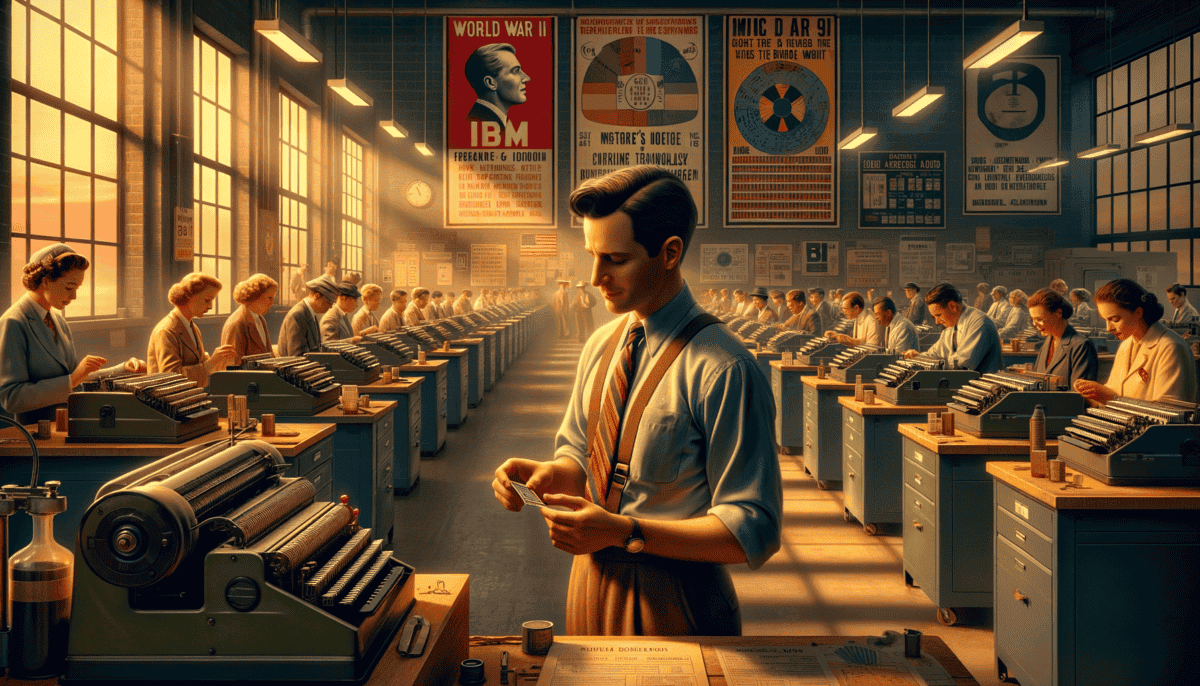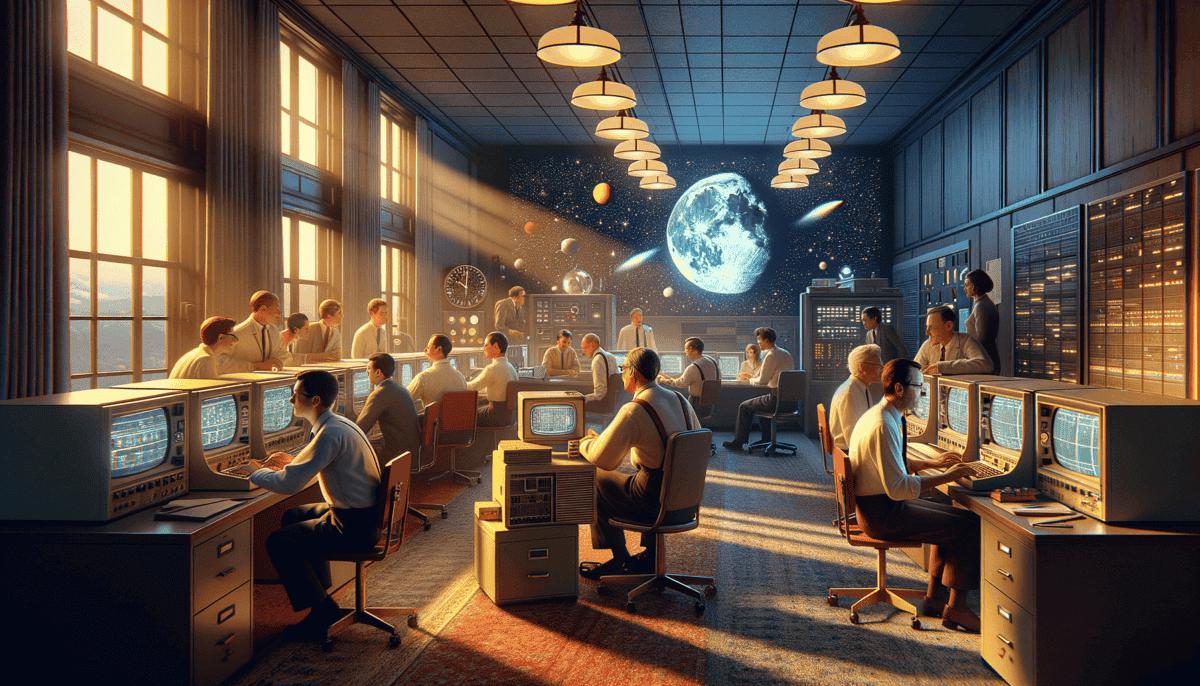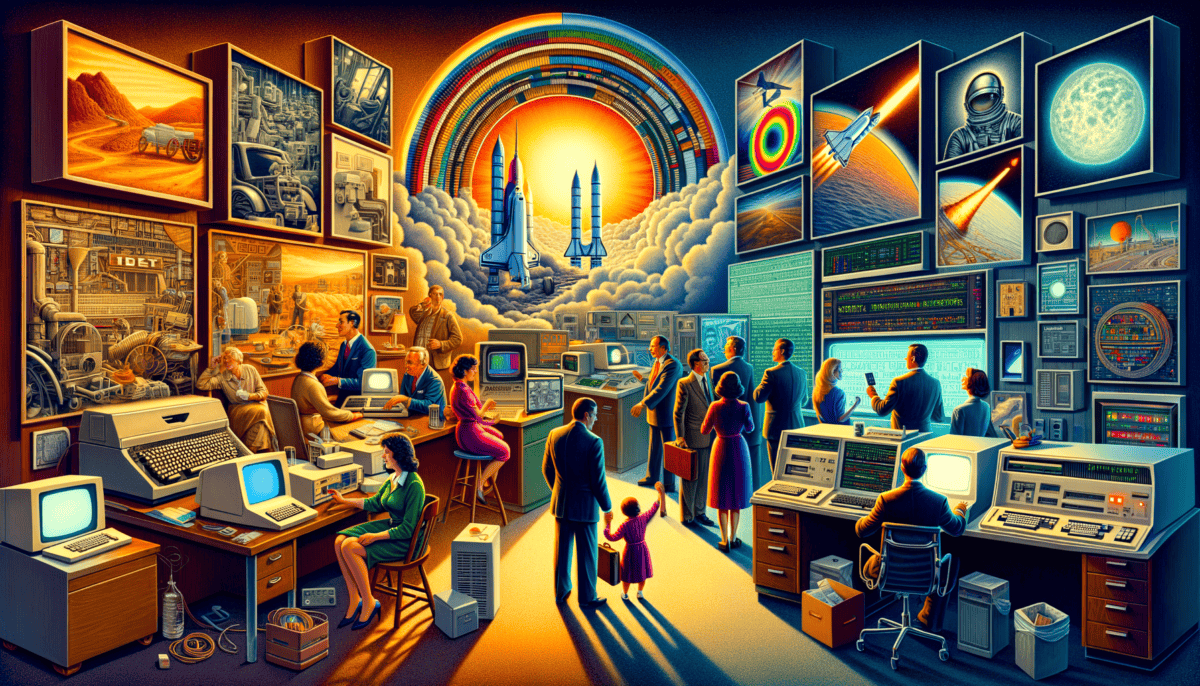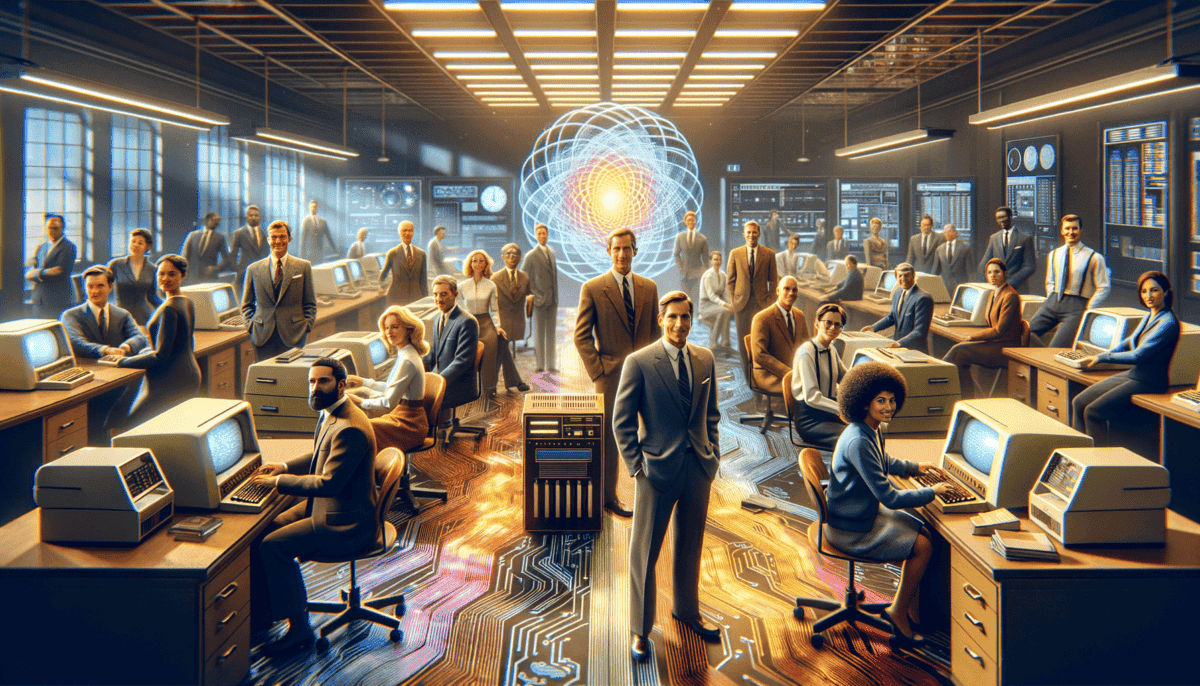A Big Dream Begins
Long ago, in 1911, a special company was born. It started in a small office in New York City. The company wasn't called IBM yet – it had a different name back then: Computing-Tabulating-Recording Company. But everyone just called it C-T-R.
Thomas Watson Sr. walked into that little office in 1914. He had big dreams in his heart and a smile on his face. "We're going to build something amazing," he told his small team. Thomas wasn't just any businessman – he was like a captain steering a ship into new waters.
Back then, the company made simple machines. They built scales to weigh things, like what you see at the grocery store. They also made time clocks that showed when workers came to work and went home. It might sound boring, but these machines were super important!
"We need to think bigger!" Thomas would say. He believed in three special words that became the company's motto:
• THINK
Thomas put this word everywhere – on signs, on notebooks, and even on walls. He wanted everyone to use their brains to solve problems and create new things.
Little did anyone know that this small company would one day help send people to the moon and create computers that fit on your desk!
The office was always buzzing with activity. Ding! Clang! went the machines as workers tested them. "These machines will help businesses work better," Thomas explained to visitors. He was right!
Thomas also cared about his workers. He paid them well and treated them like family. "Happy workers make better machines," he would say with a wink.
“The real difference is that we have faith in people.” – Thomas Watson Sr.
One day, a worker named Sarah had an idea. "What if we made our machines do more than just count time?" she asked. Thomas loved this kind of thinking! He encouraged everyone to share their ideas, no matter how big or small.
In the streets outside, horses and early cars shared the road. Inside the C-T-R building, the future was being built. The machines got better and better. They could count faster, work longer, and help businesses grow bigger.
Even when times were tough, like during the Great Depression, Thomas kept the company strong. He didn't fire workers when other companies did. Instead, he had them build new machines and think of new ideas.
"Our best days are ahead," Thomas would say. He couldn't see the future, but he knew his company would do great things. He was building more than just machines – he was building a place where people could dream big and make those dreams come true.
Every morning, Thomas would walk through the office, greeting everyone by name. "Good morning, Jim! Any new ideas today, Mary?" His friendly smile made everyone feel special and important.
The machines they built helped stores keep track of what they sold. They helped banks count money faster. They even helped the government keep track of important information. Each new machine was better than the last!
The little company that started with scales and time clocks was growing into something much bigger. But this was just the beginning of an amazing story…
War, Cards, and Big Changes
The year was 1940, and IBM (that’s what C-T-R was called now) had a new invention that would change everything – the punched card!
Picture a card the size of a dollar bill. It had tiny holes in it that machines could read. Each hole meant something different. It was like teaching machines to read!
But then something big happened – World War II began. The world needed help, and IBM stepped up. Thomas Watson Jr., the son of the first Thomas, remembered that time:
“Dad said we had to help our country win. So we turned our whole company into a workshop for victory!”
IBM’s machines worked day and night. They helped:
• Keep track of soldiers
• Plan where ships should go
• Figure out how much food and supplies were needed
The factory workers were like superheroes. Many men had gone to fight in the war, so women came to work in the factories. They built machines that helped win the war!
Sally, one of the factory workers, shared her story: “We knew every machine we built might help save lives. It made us work extra hard!”
But there was also a sad part to this story. Some IBM machines were used in bad ways during the war. This taught IBM an important lesson – technology should only be used to help people, never to hurt them.
After the war, IBM grew bigger than ever. They built new offices all around the world!
The punched cards got better and better. Schools used them to keep track of grades. Stores used them to count their stuff. Even doctors used them to help sick people!
Thomas Watson Jr. had new ideas too. He saw that machines could do more than just count things – they could solve hard problems and help people think better.
“The future is in electronic machines,” he told everyone. Some people didn’t believe him, but he knew he was right!
IBM started building bigger, faster machines. They had funny names like the IBM 604 and the IBM 701. But they could do amazing things!
The company kept growing. They built new buildings with special rooms just for their big machines. They needed lots of smart people to make the machines work, so they started schools to teach them.
"Every time we solve one problem, we find ten more interesting ones to solve," Thomas Jr. would say with a smile.
The workers were proud of their company. They wore special blue suits and white shirts. People started calling IBM “Big Blue” because of this!
But the biggest adventures were still to come. IBM was about to help humans do something nobody had ever done before – go to space! The machines that counted time and money would soon help count stars…
The punched cards that helped win a war were just the beginning. IBM was reaching for the stars, and nothing could stop them now!
Reaching for the Stars
The year was 1960. President Kennedy had a big dream – to send people to the moon! But there was a problem. How could we make sure astronauts got there safely?
NASA needed help. They needed super-smart machines to do lots of math really fast. Guess who they called? IBM!
Bob Evans, an IBM engineer, remembered that exciting time:
“When NASA called, we knew this was our chance to help make history. Our machines would help send people to the moon!”
IBM built special computers just for space travel. These weren’t like regular machines that counted money or kept track of things. These computers had to:
• Guide spaceships through space
• Keep astronauts safe
• Help them talk to Earth
• Make sure they could come back home
The astronauts loved these machines! Jim Lovell, who flew in space four times, said: “Those IBM computers were like having a super-smart friend watching over us.”
Back on Earth, thousands of IBM workers helped make the space program work. They built new machines and wrote special instructions called “programs.”
Mary Thompson, who wrote programs for NASA, shared: “Every day we came to work knowing we were helping make dreams come true!”
When Apollo 11 took off for the moon in 1969, IBM computers guided the way. They helped the astronauts know where they were going and how fast they were moving.
The whole world watched as Neil Armstrong took his first step on the moon. What they didn’t see were the IBM machines working hard to keep everything running smoothly!
But IBM didn’t stop with the moon. They helped NASA explore more of space. Their machines helped send robots to Mars and take pictures of far-away stars. ⭐
“Space is big, but our dreams are bigger,” said Thomas Watson Jr. proudly.
The space program taught IBM something important – their machines could solve really hard problems. If they could help get people to the moon, what else could they do?
Maybe they could help doctors cure sickness. Maybe they could help kids learn better. Maybe they could even help save our planet!
IBM’s next big adventure was about to begin. They were going to take the same kind of computers that helped astronauts in space and make them small enough to fit in people’s homes!
The Personal Computer Revolution
It was 1981, and IBM had a new dream. What if everyone could have their own computer? ️ Not just astronauts and scientists, but moms, dads, teachers, and kids too!
Don Estridge, known as the “father of the IBM PC,” had a special idea. He said, “Let’s make a computer that’s easy to use and fits on a desk!”
“We want to bring computers to everyone’s home, just like TV sets and telephones,” Don told his team with excitement.
The IBM team worked really hard to build this new computer. They called it the IBM Personal Computer, or PC for short.
“We made it simple enough for anyone to use,” smiled Mary Johnson, one of the designers. “You didn’t need to be a rocket scientist anymore!”
The new PC could do amazing things:
• Write letters and stories
• Play fun games
• Help with math homework
• Keep track of money
• Draw pictures
People loved the new computer! Schools bought them to help kids learn. Stores used them to count money faster. Writers used them instead of typewriters.
Tommy, a 10-year-old in 1982, remembered his first time using an IBM PC:
“It was like magic! I could play games and do my homework on the same machine. My friends thought it was the coolest thing ever!”
But IBM wasn’t alone anymore. Other companies started making their own PCs too. Apple made the Macintosh. Other companies made computers that worked just like IBM’s.
The PC changed how we live and work. Now, computers are everywhere – in our pockets, on our desks, and even in our cars!
“We didn’t just make a machine,” said Bill Lowe, an IBM leader. “We started a revolution that changed the world!”
But things were changing fast in the computer world. New companies were making faster and cheaper computers. IBM needed to think of new ways to stay special.
They started asking big questions: What if computers could talk to each other? What if they could think like people? What if they could help solve the world’s biggest problems?
The PC was just the beginning. IBM was getting ready for an even bigger adventure – teaching computers to be smarter than ever before!
Reinvention and Adaptation
The world was changing fast! Computers were getting smaller and smarter every day. IBM knew they needed to change too.
Sarah Chen, a young IBM worker, smiled as she explained:
“We’re teaching computers to think like people now. They can play chess, answer questions, and even help doctors!”
One of IBM’s coolest new friends was Watson. Watson wasn’t a person – it was a super-smart computer!
“Watson can read books, understand jokes, and even play games better than most people,” explained Tom Miller, one of Watson’s teachers.
But IBM didn’t keep all their smart ideas to themselves. They shared them with everyone! They called this “open source.” It was like sharing your favorite toys with friends.
Here are some amazing things IBM helped create:
• Computers that predict the weather
• Programs that help find lost pets
• Robots that help sick people
• Games that make learning fun
• Tools that keep our planet clean
Little Jimmy, a 7-year-old who visited IBM, was amazed:
“The computers here can do everything! They can even tell when it’s going to rain tomorrow!”
IBM also started helping people all around the world. They opened special schools called “P-TECH” where kids could learn about computers.
“We want every kid to have a chance to work with computers,” said Maria Torres, who helps run the schools.
Sometimes changing was hard. Some people missed the old IBM that made big computers. But IBM knew they had to keep growing and learning.
They started working on exciting new ideas like quantum computers – super special machines that can solve really big problems! ⚡
Bobby, a 9-year-old computer fan, asked his dad:
“Dad, will quantum computers help us talk to aliens?”
His dad laughed, “Maybe someday, Bobby. With IBM, anything is possible!”
IBM was becoming more than just a computer company. They were becoming helpers, teachers, and dreamers.
Every day, IBM workers came up with new ideas to make the world better. They helped stores sell things better, helped doctors heal people faster, and helped scientists discover new things.
The big blue company that started by making clocks was now helping to build tomorrow. And they were just getting started!
Moving into Tomorrow
The sun rises over IBM’s shiny buildings. Inside, people are working on amazing new things!
Little Ana walks through IBM’s museum with wide eyes. She sees old punch cards next to new computers that can think!
“Wow,” she whispers, “IBM has been making cool things for over 100 years!”
IBM is now working on some super exciting projects!
Here are some of IBM’s newest adventures:
• Teaching computers to fight germs
• Making phones that fold like paper
• Building computers that work like human brains
• Helping cars drive by themselves
• Finding ways to clean our oceans
Dr. Maya Lee, an IBM scientist, shows kids how quantum computers work:
“These special computers can help us make better medicine and save our planet!”
IBM also helps other companies be better at what they do. They’re like helpful teachers for grown-up businesses!
Remember the little time clock company that Thomas Watson started? Now it helps astronauts in space, doctors in hospitals, and scientists everywhere!
Bobby asks his mom while looking at an IBM robot:
“Mom, do you think I could work at IBM someday?”
“Of course!” she smiles. “IBM needs dreamers like you!”
The company that started by counting time now helps count stars in the sky. They went from making clocks to making dreams come true! ⭐
“We’re not just building machines,” says Sarah Chen. “We’re building a better tomorrow for everyone!”
IBM shows us that anything is possible if you work hard and never stop learning. They started small but dreamed big!
As the sun sets on IBM’s buildings, workers are still dreaming up new ideas. They know tomorrow will bring even more amazing adventures!
Little Ana holds her mom’s hand as they leave the IBM museum:
“Mom, I want to make cool things like IBM when I grow up!”
“You can do anything you dream of, sweetie. That’s what IBM teaches us!”
And so, the story of IBM continues. Every day brings new ideas, new dreams, and new ways to make our world better. The little company that started by counting minutes is now helping to build forever!






